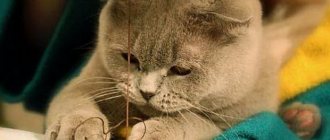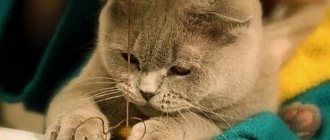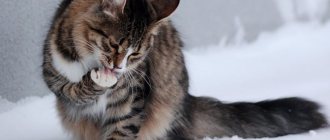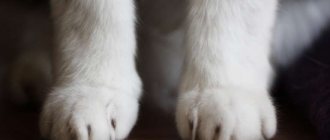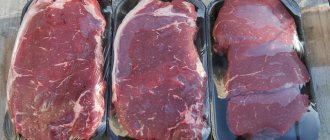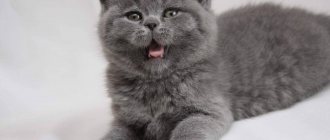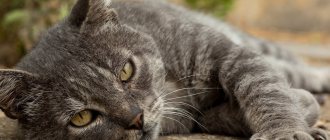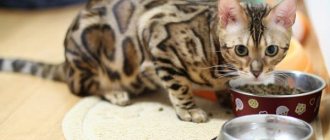The British breed has become widespread among pet lovers due to its pleasant appearance and calm character. To maintain your pet’s health and prolong its life, you should pay close attention to care and feeding, since errors in the diet, quantity and quality of food can cause the development of many diseases of the internal organs.
Power type
Disputes about the choice of food type are still ongoing. There are two options:
- ready-made food;
- natural food.
Ready-made food is produced according to certain standards, implying that the food contains a complex of nutrients, vitamins and elements. In addition, the consistency is taken into account, which corresponds to the age and weight of the animal. The cat's body cannot produce a number of substances, these include taurine, arachidonic acid, vitamin A, so these compounds must be supplied with food.
Manufacturers add the required amount of components to ready-made food, which are calculated based on the age and other parameters of the pet. Some premium products are designed specifically for British shorthair cats, which allows for an individual approach to feeding the animal. For example, manufacturers take into account the size of the jaw and also add special components that improve heart function.
Leading experts do not deny the benefits of natural nutrition. If the owner has chosen to feed the kitten homemade food, you should contact a veterinarian, who will calculate the required amount of food and describe the composition of the dishes.
The menu should cover not only the cat’s energy costs, but also replenish the deficiency of vitamins, minerals and other substances. Selecting food for an animal on your own can result in poisoning, the development of chronic diseases, and even death, so do not neglect going to the doctor.
Thus, what to feed a British kitten must be decided by the owner himself. At the same time, it is important to take into account the type of food your pet received within the walls of the nursery, since a quick transition to another feeding will not lead to the desired result - the kitten’s digestive function may be impaired and an allergy may develop.
When choosing the type of food, it is also worth considering the age and weight of the kitten. Feeding a month-old and a six-month-old pet is very different due to the fact that the body develops and grows, as well as the gradual formation of internal organs.
Many experts are inclined to believe that cat nutrition should follow the one-third rule. The principle is that the diet includes equal parts of both natural products and canned food and dry food. A comprehensive menu saturates the animal’s body with useful substances as much as possible.
Basic rules for feeding a British cat
The frequency of feeding purebred cats directly depends on their age. Small kittens up to six months old should be properly fed at least 6 times a day .
At the same time, there is no need to remove the dishes with food after feeding. A young, fragile animal should always have the opportunity to replenish lost calories. Britons over six months of age should eat no more than twice a day, in the morning and evening. After the pet eats, the cup of food is removed until the next feeding. It is important to remember that for an animal of any age you should always provide a bowl of clean water, which should be changed when it gets dirty.
But regardless of the age of the pet, there are general rules for feeding cats of all breeds:
- It is correct to feed a British cat only fresh food;
- the temperature of the food should be the same as the ambient temperature in the room;
- if a pet is fed food twisted in a meat grinder, then small balls need to be formed from it;
- cats do not really like boiled porridge or vegetables, so it is advisable to grind such products on a grater and mix them with meat ingredients;
- the volume of the side dish should not exceed a quarter of the serving;
- next to the feeding plate there should be a cup of fresh water, purified through a filter, which most people use in everyday life;
- You should not leave leftover food on the plate to prevent harmful bacteria and microorganisms from appearing;
- it is important to establish a regular feeding schedule at the same time, which suits both the cat and its owner;
- After a British cat has eaten, you need to leave it alone and not try to play with it.
You cannot feed your pet very hot or, conversely, cold food . Only thanks to a healthy and moderate diet will the fur of a domestic cat be soft and silky.
General rules for feeding the British and depending on age
Cats are carnivorous animals, so their diet must contain sufficient protein. The amount of food depends on the individual parameters of the pet. On average, an adult requires about 300 g of food, while kittens only 150 g. You must not exceed the prescribed amount of food, since excess calories leads to excess weight, which, in turn, threatens the development of dangerous diseases of the cardiovascular, gastrointestinal tract. intestinal and endocrine systems.
If the owner has chosen natural food, it is prohibited to give food from the table. Such feeding is dangerous for the pet's life. Natural food involves separate processing of products according to special recipes developed by veterinarians. The difficulty lies in the fact that independent selection of food leads to the fact that the cat’s body receives an insufficient amount of nutrients, and some food is enriched with harmful compounds. Without knowledge of cat physiology, it is difficult to choose the necessary diet.
If the animal has been castrated, veterinarians recommend switching the pet to specialized premium food. This is due to the fact that sterilization increases the risk of developing diseases of the genitourinary system. Changing your diet helps prevent the occurrence of pathologies.
Month
By the first month of life, the kitten, as a rule, gradually moves away from breastfeeding. You can replace mother's milk with cow's milk, but it is better with goat's. During this period, the owner should carefully introduce new products. The food should be soft or liquid and include a large amount of protein. The feeding schedule is five times a day. This is explained by the rapid growth of a young organism, which requires a lot of energy.
Food is heated to a comfortable temperature; you should not give your baby cold or hot food. Experts recommend giving kittens chicken broth, baby purees made from meat.
Gradually, the menu includes more solid food - fresh minced chicken or turkey, finely chopped fruits and vegetables.
Eating ready-made food means choosing premium manufacturers. Cheap products are not suitable for a baby, since such food contains fewer nutrients than a growing body needs.
2 months
At the age of two months, the kittens’ menu gradually includes chicken meat cut into small slices, vegetables, and fruits. Cereals are boiled in a large volume of water so that the consistency is liquid. The diet can be enriched with various cereals.
It is not recommended to reduce the number of meals at two months of age, so kittens are fed about five times a day. At two months, a kitten should not completely give up dairy products. Cow's milk or fermented baked milk, when fed correctly, makes up 50% of all products received.
Six months
At six months, the kitten is given pre-scalded, cooked or raw meat, which is introduced starting from the age of three months. The meat portion should be up to 30-40 g. Preference is given to chicken, turkey, beef and rabbit. These varieties contain the least amount of fat. Chopped vegetables are an obligatory component of the menu. You can also give purees.
At this stage, reduce the amount of feeding to three times a day. Also, six months of age is ideal for introducing ready-made food and a variety of canned food into the diet. Preference is given to premium and super-premium class. The introduction of finished products should be gradual. If your kitten reacts poorly to a new food, you should change the manufacturer or contact your veterinarian.
From one year and older
Upon reaching one year, the kitten turns into a young individual, as a result of which the processes of growth and development and their speed change, and, consequently, energy needs. At this stage, the owner chooses the type of feeding - natural, ready-made food or mixed. In any case, it is recommended to have an examination by a veterinarian and get a professional diet selection.
A one-year-old pet is fed twice a day. The daily food intake is about 250-300 g. The amount of food depends on the initial weight of the pet and its temperament. If the cat is active, it needs more food. For phlegmatic animals, the total weight of food is reduced to the lower limit of the physiological norm in order to avoid the deposition of excess weight.
Vitamins in the diet
An important aspect is the presence of age-appropriate vitamins that promote the active growth of the kitten. The number of feedings (meals) up to six months should be six, by 10 months - four. Frequent feeding is due to the small size of the stomach of British kittens.
It is recommended to keep British cats over a year old on 2-3 meals a day of dry and wet food; show cats can consume approximately equal portions of food of these types. All others are in the proportions of 70% dry food, 30% wet food.
At home, the daily menu includes lean meat (turkey, rabbit, beef, chicken and the like), internal and less valuable parts of slaughtered animal carcasses, marine varieties of lean fish, oats and wheat sprouts (sprouted), herbs, egg yolks , porridge from semolina, rice, buckwheat, barley, wheat cereals.
Grass must be included in the cat's diet; it can be bought or grown from seeds. Giving begins at 7-8 months. Cats independently determine which part is the top or base of the stems. The purpose of the grass is to ensure that the animal does not leave the premises during its life,
It is important to note that in order to exclude pet diseases, it is strictly forbidden to include raw yolks, and even more so, whites in any form. Milk is completely out of use at the age of 6-8 months. Changes in diet should take place in accordance with the advice or opinion of a veterinarian and the age and health of the cat.
Mr. Cat recommends: When to introduce complementary foods
Veterinarians advise introducing complementary foods starting at three weeks. At this time, the kitten can gradually accept new food and wean itself off mother's milk. To reduce the body's stress in response to the arrival of an unknown product, complementary foods are introduced gradually.
Start with small amounts and watch the animal's reaction. If the kitten refuses to eat, you should not continue to force feed it.
Using dry food for feeding
If the owner of a British cat decides to feed his cat dry food, then he must understand that it is important to choose its composition and manufacturer. First of all, preference should be given to Premium class food. It is also important that the four-legged family member likes him. The British are very picky when it comes to food . Therefore, there is no point in buying large packages of food, even if it is the best on the pet store counter. To begin with, you should select several varieties in economical packages and see what the cat likes.
Also, when choosing the right type of dry food, it is important that it is available for sale, that is, you do not need to look for it in different stores in the city. Once the food has been selected, it is not recommended to change it to other varieties. The cat's body gets used to one food, and it is very difficult for a cat to adapt to another type of feeding. If a domestic cat eats dry food, it is important to ensure that there is always a container of clean and fresh water near the bowl.
Proper diet for a British kitten
An optimal diet is important for a growing kitten, as food allows the small body to develop. Before purchasing a pet, you should carefully study the feeding rules.
A small pet requires five to six meals a day. In this case, the daily ration does not exceed 150 g.
The owner should constantly monitor the drinking bowl - it should always be full. Prolonged lack of water leads to dehydration of the body. For kittens, this situation is most critical due to their low body weight and imperfect formation of internal organs and adaptive systems.
If there are signs of hypovitaminosis, you should contact your veterinarian. Your doctor will help you choose the right vitamin complex and other biological supplements.
If an animal has a food allergy, it is recommended to exclude the allergen product from the diet and conduct a veterinary examination.
What should not be used in British cat food?
Under no circumstances should the food of a British breed cat contain the following products:
- Fish or poultry bones that can cause a pet to choke or, worse, damage the stomach wall and die.
- It is not recommended to give lamb, turkey or goose meat to Britons. Such meat products are poorly digested by the stomach of a domestic cat.
- Products with high fat content, as well as any smoked food, cause all sorts of disruptions in the functioning of the cat’s stomach. Their use often causes various unpleasant diseases.
- You should not spoil your pet with sweets. They lead to decreased immunity and tooth damage.
- You cannot feed cats potatoes, since starch, which is contained in large quantities in the product, is absolutely not digestible in the animal’s stomach. Therefore, it can lead to digestive problems.
- It is strictly contraindicated to give vitamins or medications for human use to Brits. They are absolutely not intended for animals and can be fatal.
If you follow the advice of professionals and strictly adhere to a balanced diet and feeding time, the British cat will be active, cheerful and delight its owners with playfulness and affection.
Prohibited Products
Including certain foods in the diet of British Shorthair cats can have serious consequences.
- Milk can only be given to kittens up to six months old. This is due to the fact that in childhood a large amount of the enzyme lactase is secreted. This compound is necessary for the digestion of milk, namely, for the destruction of glycosidic bonds of disaccharides. As the pet grows and develops, the production of this enzyme gradually ceases. This situation leads to the fact that the pet cannot completely digest the milk. Consumption of the product as an adult can affect the condition of the digestive system. The clinical picture is usually represented by stool disturbances, general malaise and vomiting.
- Pork is the most dangerous meat in terms of helminthiasis. Most parasites are localized in the internal organs and muscles of cattle. Moreover, pathogens can be in different states - both at the larval and adult stages. As a result of the fact that pigs often receive uncleaned feed, helminths can enter their body. Raw meat containing the pathogen infects the cat. The further clinical picture depends on the type of parasite. But in most cases, helminthic infestation without treatment leads to severe depletion of the body and death of the animal. In the early stages of the disease, complete recovery is possible in 95-100% of cases. Pork is also dangerous in terms of fat content. Excessive intake of lipids and cholesterol can provoke serious diseases of the cardiovascular system in the animal in the future. Therefore, preference is given to dietary meat varieties.
- Food from the owner's table is strictly prohibited for the pet. Fried, spicy, highly salted, smoked foods can lead to poisoning of the body, the development of gastritis and peptic ulcers if the animal is regularly fed incorrectly. The cat is a carnivorous predator, so food should be close to natural nutrition in nature.
- Plants of the legume family create unfavorable conditions in the intestinal lumen - fermentation occurs during digestion. The pet experiences discomfort in the abdomen due to increased formation of gases.
- Chicken and fish bones are dangerous for cats, as there is a risk of them getting into the respiratory tract. In addition, trauma to the soft tissues of the oral cavity is possible, followed by suppuration in the area of damage.
- Dietary supplements, vitamins, and medications intended for humans are strictly prohibited from being given to cats. Despite the fact that usual medications are used in veterinary practice, if a pet becomes ill, they should be purchased through veterinary pharmacies. This is due to the fact that the products have special dosages and dilutions intended for use by animals.
1111
Diet and feeding regime of the British
Adult cats of the British breed are fed no more than once a day in the summer heat, and twice a day in all other seasons.
It is very important that the cat is fed according to a schedule. Balanced cat food per kilogram of weight may consist of the following ingredients:
- beef meat – 20 Gy;
- soft cheeses – 10 G;
- cereal – 4 Gy;
- sunflower oil – 0.2 G.
By adhering to proper nutrition, the cat will live a long time without illness, without visiting a veterinarian, delighting its owners with a grateful purr.
Nutritional features of a pregnant cat
A pregnant cat needs special and enhanced nutrition. The diet should include veal, chicken, and beef. Sometimes you can feed fish, as long as there are no bones in it. It is recommended to give the “future mother” dairy products - kefir, cottage cheese, sour cream and others. There must be vegetables. This is necessary to ensure that the body receives the necessary vitamins.
Bone meal can be used as an additional additive. Sometimes pregnant cats may have problems with bowel movements. To eliminate this problem, broths containing meat and warm milk are introduced. Sausage, sweets, and foods with seasonings should be completely excluded. Such foods can cause diseases such as kidney stones and heart failure.
A nursing cat needs an enhanced diet.
What to feed a cat after giving birth
During the first few days, the cat may completely refuse to eat. There's nothing wrong with that. The main thing is that the cat drinks water during this period. Mom needs to give food more often - 5-6 times a day. Veterinarians advise switching the cat to liquid food in the first weeks.
New products are gradually being introduced - meat, vegetables. If the cat is on a ready-made diet, many manufacturers have specially formulated foods in their product line.
For spayed and neutered
Royal Canin Male for the prevention of urolithiasis
pros
- Good coat condition
- No side effects
- Disease Prevention
Minuses
- High price
From 313 RUR
Dry food for castrated British cats from 1 year to 6 years. The product prevents the occurrence of urolithiasis and obesity. Veterinarians advise owners to feed their pets with food from this series after operations related to sterilization. Based on nutrition, problems of the gastrointestinal tract are solved: cats with sensitive stomachs stop regurgitating. An excellent option for cats after castration; in most cases, urolithiasis does not develop.
Bozita for the prevention of urolithiasis, with chicken
pros
- Affordable price
- Increased fiber content
- Contains fresh meat
- Practical packaging
- The packaging does not allow the smell to dissipate
- Suitable for older cats
- Contains a natural immunostimulant
Minuses
- Not found
From 358 ₽
The product is suitable for indoor and adult cats from 1 to 6 years of age. The food is selected taking into account the age characteristics of sterilized and elderly cats. Chicken meat in the diet is easily digestible, L-Carnitine normalizes the metabolism of sedentary animals. The dry product boosts the cat's immunity.
Natural food for the British cat
Leftover food from the host's table will not work. A separate balanced diet is required.
Classic ratio: meat – 69-70%, cereals – 10%, vegetables – 20-30%.
Animal and plant products should be included in the diet. The animal's body requires beef and poultry. Pork should be excluded.
The preferred cereals are oatmeal, rice, and buckwheat.
Vegetables that do not contain starch are beneficial. These are carrots, beets, zucchini, any cabbage.
Dairy products must be low-fat and unsweetened. Cottage cheese, fermented baked milk, kefir are useful.
Heat treatment of products is not always required. Vegetables and meat can be given both boiled and raw. Meat must be frozen first to remove parasite eggs. It is better to mix minced meat with vegetables. Porridge needs to be boiled in water.
The opinion that fish is very healthy is not entirely correct. It increases the load on the kidneys, disrupting the mineral balance. With constant feeding of seafood, urolithiasis, vitamin deficiency, allergies, and hair problems may develop.
If an animal likes to feast on fish, then it can be offered only 1-2 times every 10 days. It is forbidden to feed the raw product; it must be boiled and the bones removed.
Mixed nutrition - the choice is yours
You, dear owners of British cats, must decide which feeding option is right for you, and then bear responsibility for your choice and for the health of your animal. You may also find it useful to read the article “Prevention of ICD in neutered cats.”
5. You cannot feed or give dry food as a treat during natural feeding, and vice versa. Not once a week, not once a month, not possible.
6. It is strictly not recommended to mix food from different manufacturers. If you feed your British animal dry food and want to diversify the diet with wet canned food, then this should be no more than 25% of the daily diet, and the canned food should be from the same manufacturer and from the same line of food.
